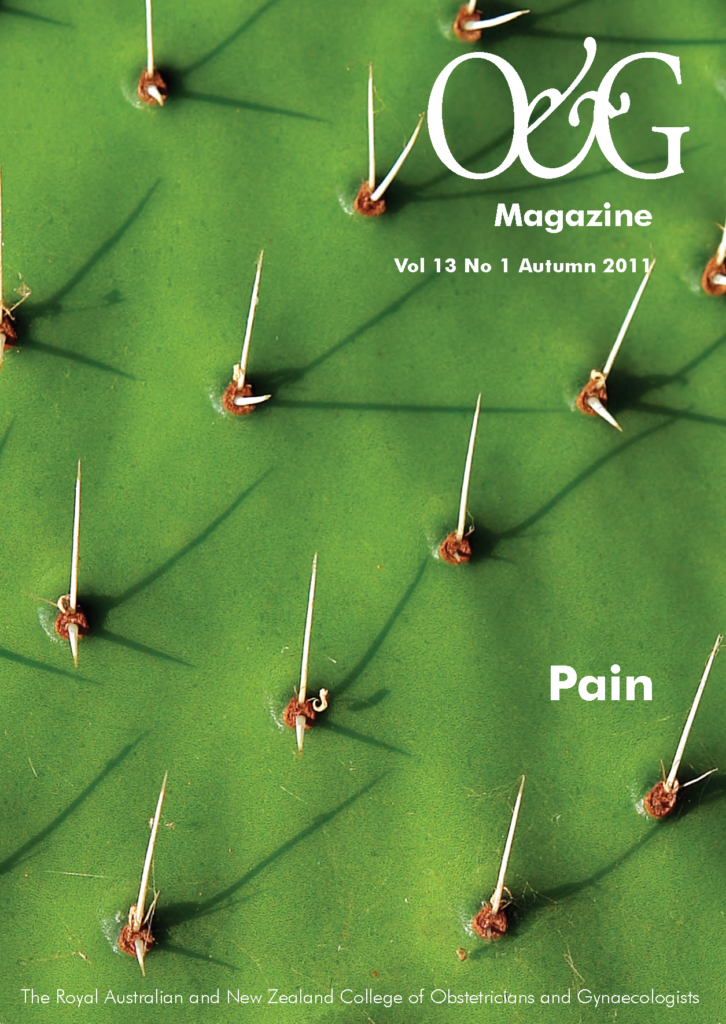Primary dysmenorrhoea, usually presenting in the early teenage years, continues to be the province of the general practitioner. Effective treatments are available and the diagnosis should be reconsidered if there is limited or no response.
Primary dysmenorrhoea is characteristically described as colicky pain associated with menstruation, beginning on the first day of bleeding and usually most severe then and, on days two-three of the cycle, gradually tapering off towards the end of the menstrual flow. Pain is most commonly reported as central and suprapubic, although it may also radiate to the back and thighs. Primary dysmenorrhoea is usually first experienced some months or even one or two years following the menarche and is characteristically not present during anovulatory cycles preceding the onset of regular menstrual periods. Pain may be mild, moderate or severe, and may begin a few hours before or after the onset of vaginal bleeding, but its FRANZCOG presentation tends to be similar from one cycle to another in the same individual. Primary dysmenorrhoea may cause repeated absences from school, sporting and/or social activities and so may significantly impact on a young woman’s education, sporting career and lifestyle.
Primary dysmenorrhoea is caused by myometrial contractions producing uterine ischaemia in response to elevated levels of prostaglandins E2 and F2α released from shedding secretory endometrium. Myometrial contractions can last several minutes, with uterine pressures of more than 60 mm of mercury, resulting in severe pain. Prostaglandins may also cause commonly associated symptoms, including nausea, vomiting, dizziness and faintness, and these also tend to recur from one cycle to the next. Though by definition ‘primary’ dysmenorrhoea is ‘physiological’, it is a common condition experienced in diverse populations around the world. It is also significantly under-reported by women suffering it and so an open-ended question about menstrual history is an essential part of any medical consultation with a young woman.
There are two common presentations of primary dysmenorrhoea in general practice. The first occurs in the early teenage years, typically 11–13 years age group, usually after a few months of established and fairly regular cycles. The girl may present with her mother and the complaint is usually straightforward – painful periods, often disrupting school and sporting attendance. Part of the consultation should be spent with the girl alone – provided she is agreeable to this – emphasising to the mother that this is normal practice. This enables the patient to express any concerns she may have that she does not wish to share with her mother; in particular, she may be sexually active or contemplating becoming so, which may affect decisions about management. From time to time, a mother may be excessively concerned about her daughter’s condition, offering information about her own and her family menstrual history. While it is important that maternal or family history, particularly of endometriosis, is not overlooked, the view that even normal menstruation is a ‘curse’ still lingers with some mothers. It is an important part of the practitioner’s role to ensure that that the girl understands and does not come to see her normal physiology from a negative point of view. Describing a ‘normal spectrum’ of period pain, from mild to severe, asking her about her friends’ experiences and placing herself and her friends on this spectrum, can help give her a balanced view of her condition, as can positive reassurance about the efficacy of available treatments.
Younger teenagers should have an adequate history taken, but if they are in good general health, give a characteristic history of primary dysmenorrhoea and are not sexually active there is no indication for a vaginal examination or for pelvic ultrasound or other investigations, although clinical examination of the abdomen is essential. Abdominal examination can help exclude ovarian masses and also may identify constipation, which can mimic or indeed exacerbate dysmenorrhoea and is particularly prevalent in the young, slim picky eater.
The majority of patients with dysmenorrhoea will respond to non-steroidal anti-inflammatory drugs (NSAIDs) if these are taken correctly. These drugs are prostaglandin synthetase inhibitors, which act by inhibiting the cyclooxygenase enzymes (COX enzymes) hence preventing the formation of prostaglandins. They therefore prevent pain in the future but cannot reverse pain already present. It is essential that all women taking NSAIDs for primary dysmenorrhoea fully understand this concept if they are to benefit appropriately from their use. Several studies have shown that patients reporting they had found NSAIDs ineffective had, in fact, not taken them until many hours after the pain had begun.
There are more than 70 well-conducted randomised controlled trials (RCTs) testifying to the effectiveness of NSAIDs in the prevention of primary dysmenorrhoea when compared to placebo and other treatments. Studies have also shown that no particular NSAID stands out as significantly more effective than any other. Naproxen, mefenamic acid and ibuprofen are those most commonly and effectively used in Australian practice at the present time and can be bought over the counter. One limiting factor is side effects, mostly gastro-intestinal; patients should be advised to take preparations with food or milk and to take them only as long as needed each cycle. Most young women quickly become aware of the systemic and pelvic symptoms of an incipient period, and will be helped by keeping a menstrual calendar, so that the chosen NSAID can then be taken at an appropriate time prior to the onset of pain. It is also useful to make practical suggestions to this younger age group and recommending that a couple of tablets are kept at hand in the school bag together with an emergency supply of sanitary products is often helpful. Many young girls either before their first period or in the first few years following menarche live in terror of leaving ‘little red puddles’ on clothing and so forth and are greatly reassured by such strategies.
The second common presentation in general practice is of the slightly older teenager, who suffers similar pain and symptoms, and often has already tried NSAIDs. These young women are more likely to be sexually active than the first group, or to be contemplating becoming so, and this may be part of their motivation in presenting when they do. They are likely to be aware that the combined oral contraceptive pill (COCP) is a very effective treatment for dysmenorrhoea and may find that a prescription for COCP for dysmenorrhoea is more acceptable, to themselves and/or parents, than one intended purely for contraception. Certainly the COCP (in a monophasic formulation), which produces a thin atrophic endometrium and hence minimises prostaglandin production, may safely be prescribed as first-line treatment in any young woman with dysmenorrhoea who reports that she is sexually active, including younger teenagers. (Interestingly, there are few RCTs of COCP in the literature to support use for dysmenorrhoea although this is widespread and apparently effective practice.) Adolescents are also not infrequently troubled by moderate to severe acne, which may be trivialised by the girl’s parent/s. An astute practitioner will enquire about these issues and discuss the well-documented benefits of some formulations of COCP in acne vulgaris.
A full medical history should be taken, to rule out any contraindications to COCP. The decision to perform a vaginal examination at the first consult for dysmenorrhoea in this young age group is a difficult one and should be assessed on a case-by-case basis. Girls who give a history of being sexually active should be encouraged to have a vaginal examination, with Pap smear (following NHMRC Guidelines) and swabs for STIs if appropriate. Many of these patients are relieved and reassured to have a check up and STI screen. Those girls who have not yet commenced sexual activity do not require a vaginal examination, but should be informed of NHMRC guidelines and checkups discussed for the future. When prescribing COCP, even for young women who are not sexually active, information about side effects and the situations in which it may not be effective as a contraceptive should be provided and the woman made aware that it does not protect against STIs. Parents’ concerns regarding these detailed instructions are often allayed with gentle reassurance that it is important to know ‘the proper way to take the medication’.
In women who continue to experience pain with withdrawal bleeds on COCP the active pills may be taken continuously for six months or more; women can be assured of the safety of this approach. The levonorgestrel rod and depot medroxyprogesterone acetate have also been demonstrated to be effective treatments for primary dysmenorrhoea as well as effective contraceptives. Interestingly, a considerable number of female teenagers unfortunately discount the rod through needle phobia.
In general, a holistic approach to management should be taken, with attention to diet and lifestyle as well as prescription of medication. Regular exercise has been demonstrated to reduce the severity of symptoms of dysmenorrhoea; both smoking and passive inhalation of cigarette smoke have been demonstrated to increase the severity of these symptoms. For women who wish to avoid conventional medication, acupuncture and acupressure have been shown to have limited success with symptoms; there is less demonstrable benefit from transcutaneous nerve stimulation (TENS) and Japanese and Chinese herbs, and none whatever from spinal manipulation.
Significant variations to either of these two common presentations should alert the practitioner to the possibility of underlying pathology. Period pain dating from the menarche may be the consequence of uncommon, but surgically correctable, malformations of the genital tract, leading to obstruction to the menstrual flow. Period pain commencing some years after the menarche should be regarded as secondary until conditions such as endometriosis, pelvic infection and intrauterine polyps have been excluded. Women with an apparent diagnosis of primary dysmenorrhoea who do not respond to either NSAIDs or the COCP also should have the possibility of an underlying cause, in particular endometriosis, reconsidered. Laparoscopy, preferably by a practitioner experienced in the diagnosis of endometriosis in younger women (in whom red flame, white and clear lesions are more common than the darker lesions often found in older women), is essential for the diagnosis and may be accompanied by surgical treatment of the endometriosis.
Primary dysmenorrhoea is a common condition, known to be under-reported by women even when severe and still causing in Australia significant time out from school attendance, employment and social events, yet it is easily diagnosable and treatable by general practitioners. We urge our fellow practitioners to become more proactive in its detection and management.
References
Society of Obstetricians and Gynaecologists of Canada. Primary Dysmenorrhea Consensus Guideline. No 169, December 2005. At www. sogc.org/guidelines/public/169E .
Smith CA, Zhu X, He L, Song J. Acupuncture for primary dysmenorrhoea. Cochrane Database Syst Rev 2011; Jan 19: CD007854.
Zahradnik HP, Hanjalic-Beck A, Groth K. Non-steroidal anti-inflammatory drugs and hormonal contraceptives for pain relief from dysmenorrhea: a review. Contraception 2010; 81 (3): 185-96.
Marjoribanks J, Proctor M, Farquhar C, Derks RS. Non-steroidal anti-inflammatory drugs for dysmenorrhoea. Cochrane Database Syst Rev 2010; Jan 20; (1) CD 001751.
Morrow C, Naumburg LH. Dysmenorrhea. Prim Care 2009; 36 (1): 19-32.







Leave a Reply